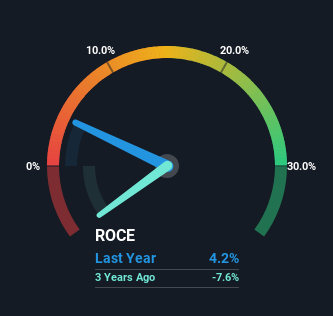- Japan
- /
- Transportation
- /
- TSE:9020
Returns On Capital Signal Difficult Times Ahead For East Japan Railway (TSE:9020)
To avoid investing in a business that's in decline, there's a few financial metrics that can provide early indications of aging. Typically, we'll see the trend of both return on capital employed (ROCE) declining and this usually coincides with a decreasing amount of capital employed. This indicates the company is producing less profit from its investments and its total assets are decreasing. On that note, looking into East Japan Railway (TSE:9020), we weren't too upbeat about how things were going.
Understanding Return On Capital Employed (ROCE)
Just to clarify if you're unsure, ROCE is a metric for evaluating how much pre-tax income (in percentage terms) a company earns on the capital invested in its business. To calculate this metric for East Japan Railway, this is the formula:
Return on Capital Employed = Earnings Before Interest and Tax (EBIT) ÷ (Total Assets - Current Liabilities)
0.042 = JP¥345b ÷ (JP¥9.8t - JP¥1.6t) (Based on the trailing twelve months to March 2024).
Therefore, East Japan Railway has an ROCE of 4.2%. In absolute terms, that's a low return but it's around the Transportation industry average of 4.8%.
Check out our latest analysis for East Japan Railway

In the above chart we have measured East Japan Railway's prior ROCE against its prior performance, but the future is arguably more important. If you'd like to see what analysts are forecasting going forward, you should check out our free analyst report for East Japan Railway .
What Can We Tell From East Japan Railway's ROCE Trend?
In terms of East Japan Railway's historical ROCE movements, the trend doesn't inspire confidence. To be more specific, the ROCE was 7.0% five years ago, but since then it has dropped noticeably. On top of that, it's worth noting that the amount of capital employed within the business has remained relatively steady. This combination can be indicative of a mature business that still has areas to deploy capital, but the returns received aren't as high due potentially to new competition or smaller margins. If these trends continue, we wouldn't expect East Japan Railway to turn into a multi-bagger.
The Bottom Line
In summary, it's unfortunate that East Japan Railway is generating lower returns from the same amount of capital. Long term shareholders who've owned the stock over the last five years have experienced a 16% depreciation in their investment, so it appears the market might not like these trends either. With underlying trends that aren't great in these areas, we'd consider looking elsewhere.
If you want to know some of the risks facing East Japan Railway we've found 2 warning signs (1 shouldn't be ignored!) that you should be aware of before investing here.
If you want to search for solid companies with great earnings, check out this free list of companies with good balance sheets and impressive returns on equity.
Valuation is complex, but we're here to simplify it.
Discover if East Japan Railway might be undervalued or overvalued with our detailed analysis, featuring fair value estimates, potential risks, dividends, insider trades, and its financial condition.
Access Free AnalysisHave feedback on this article? Concerned about the content? Get in touch with us directly. Alternatively, email editorial-team (at) simplywallst.com.
This article by Simply Wall St is general in nature. We provide commentary based on historical data and analyst forecasts only using an unbiased methodology and our articles are not intended to be financial advice. It does not constitute a recommendation to buy or sell any stock, and does not take account of your objectives, or your financial situation. We aim to bring you long-term focused analysis driven by fundamental data. Note that our analysis may not factor in the latest price-sensitive company announcements or qualitative material. Simply Wall St has no position in any stocks mentioned.
About TSE:9020
East Japan Railway
Operates as a passenger railway company in Japan and internationally.
Acceptable track record second-rate dividend payer.
Similar Companies
Market Insights
Community Narratives



